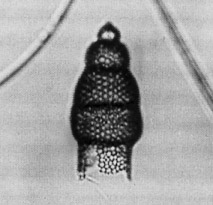 Stichocorys
peregrina (Riedel)
Stichocorys
peregrina (Riedel) Stichocorys
peregrina (Riedel)
Stichocorys
peregrina (Riedel)Eucyrtidium elongatum peregrinum Riedel, 1953, p.812, pl.85, fig.2; Riedel, 1957, p.94
Stichocorys peregrina (Riedel), Sanfilippo and Riedel, 1970, p.451, pl.1, fig.10; Westberg and Riedel, 1978, p.22, pl.3, figs.6-9
Shell with seven (or more) segments distinctly separated by constrictions, the first four segments together forming a conical section, the subsequent segments an approximately cylindrical section. Cephalis subspherical, rough, poreless, and bearing, usually eccentrically, a straight or curved conical horn of the same length. Thorax hemispherical with rough surface, having some 40 subcircular pores, which are irregularly arranged and 1.5-3 times as broad as the intervening bars. Third segment conical, usually longer than any other, and fourth segment a cylinder bulged laterally to a greater or less degree; these two segments with a rough surface, and circular pores 2-4 times as broad as the bars, often regularly arranged in indistinct vertical series, 7-9 in a vertical row on each segment, 14-20 on a half equator. Segments subsequent to the fourth are generally shorter and narrower than the third and fourth, subcylindrical and laterally bulged: their surfaces are smooth, with irregularly disposed subcircular pores, 2-5 times as broad as the bars. The entire apertural margin of the shell was not observed, though it might be expected to be not greatly constricted, without radial apophyses (Riedel, 1953).
Length of the first four segments 125-135 µm; greatest breadth (in the lower part of the third segment, or the middle of the fourth) 70-80 µm. Breadth of cephalis 20 µm; of thorax 35-40 µm; of fifth segment 60-65 µm. Length of cephalis 12-15 µm; of thorax 20-25 µm; of third segment 35-50 µm; of fourth segment 30-40 µm; of subsequent segments 20-45 µm (Riedel, 1953).
The upper conical part of the shell consists of three segments, and the fourth is equally robust. The third segment is long, truncate conical, and the thorax short (Riedel and Sanfilippo, 1978a).
Westberg and Riedel (1978) placed an additional restriction on the identification of this species, i.e. "that the width of the top quarter of the fourth segment must be at least as great as the maximum width of the third segment."
In Stichocorys delmontensis, the cylindrical part of the shell begins below the third segment, rather than below the fourth. In Eucyrtidium calvertense Martin (1904, p.450, pl.130, fig.5) and E. inflatum Kling (1973, p.636, pl.11, fig.7, pl.15, figs.7-10) the pores of the third and the fourth segments show a pronounced longitudinal alignment, which is lacking in Stichocorys peregrina (Sanfilippo et al., 1985).
In typical, low-latitude forms, the third segment is long and pronouncedly conical, the fourth is wider than the third, and the subsequent segments are narrower and constitute a cylindrical lower part of the shell. In latitudes higher than about 20°, and in areas of cold boundary currents, the skeleton tends to be more robust, the third segment is shorter and less obviously conical, and the fourth segment is rarely pronouncedly wider than the third (DSDP Sites 223, 303, 310, 173, 84, 157, 362). In its extreme development, this tendency leads to forms in which the segments uniformly increase in width distally. The specific name has only been used for forms in which the width of the top quarter of the fourth segment is at least as great as the maximum width of the third, though this may be an artificial delimitation in view of the tendency described above. Nevertheless, we perpetuate it here because it is not certain that the forms becoming pronouncedly narrower after the fourth segment are conspecific with those expanding uniformly, and the definition applied until now has served to delimit a stratigraphically useful early to middle Pliocene species in low latitudes (Sanfilippo et al., 1985).
The evolutionary transition of Stichocorys peregrina from Stichocorys delmontensis defines the base of the Stichocorys peregrina Zone. Its morphotypic last appearance defines the base of the Pterocanium prismatium Zone and is a synchronous event, at least, in low latitudes.
This species evolved from Stichocorys delmontensis, and became extinct without leaving any descendants.
See Holdsworth (1975) for discussion of some difficulties with regard to the identification of S. peregrina and S. delmontensis at DSDP Site 289.
Reynolds (1980) defines the base of his Theocorys redondoensis Zone (late Miocene) in the western North Pacific by the evolutionary transition from Stichocorys delmontensis to S. peregrina.
The Lamprocyclas heteroporos Zone of Hays (1970) and emended by Kling (1973) in the North Pacific is defined by the last occurrence of Stichocorys peregrina. This zone is uppermost Pliocene and falls within the Pterocanium prismatium Zone in the equatorial Pacific.